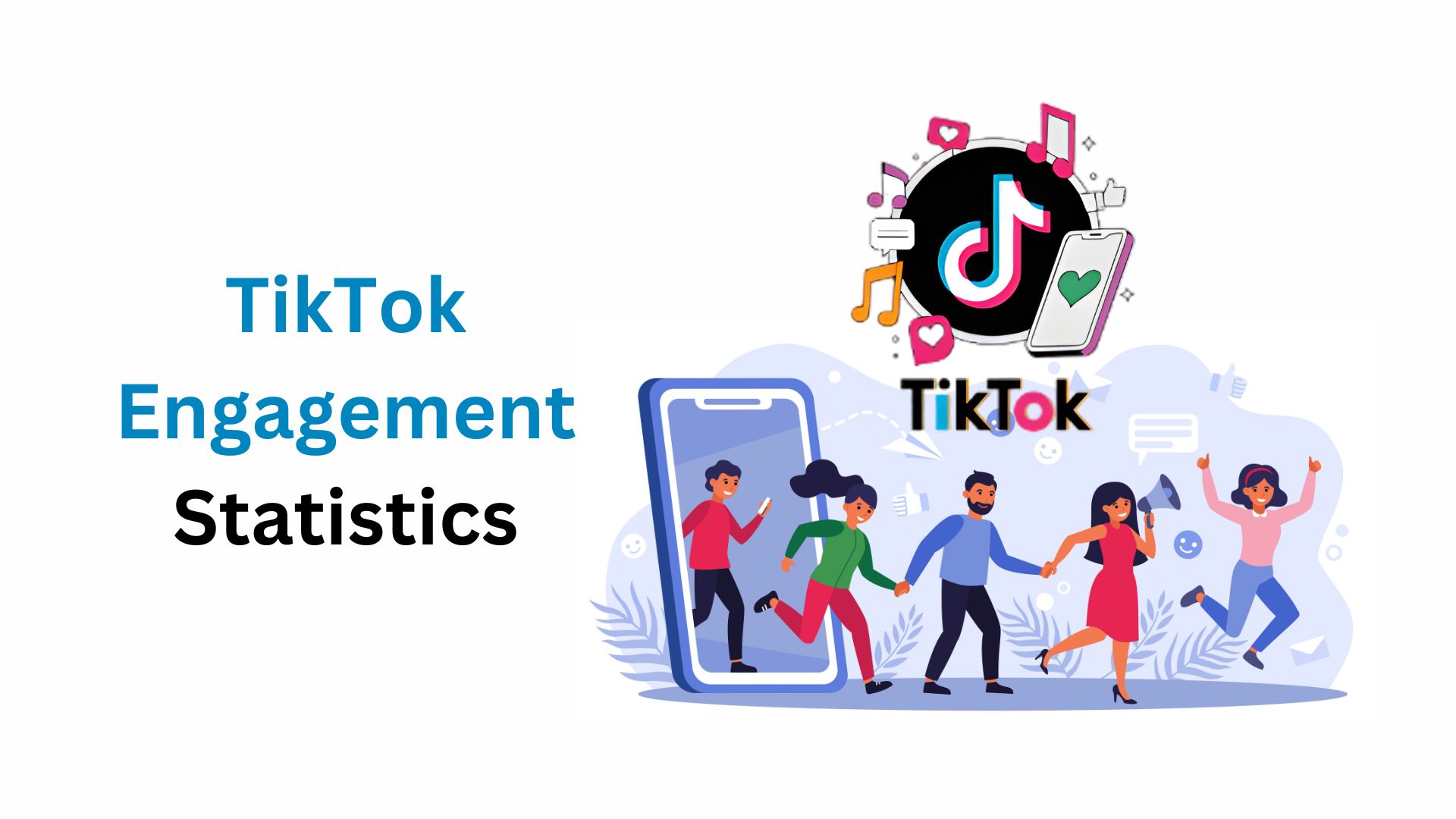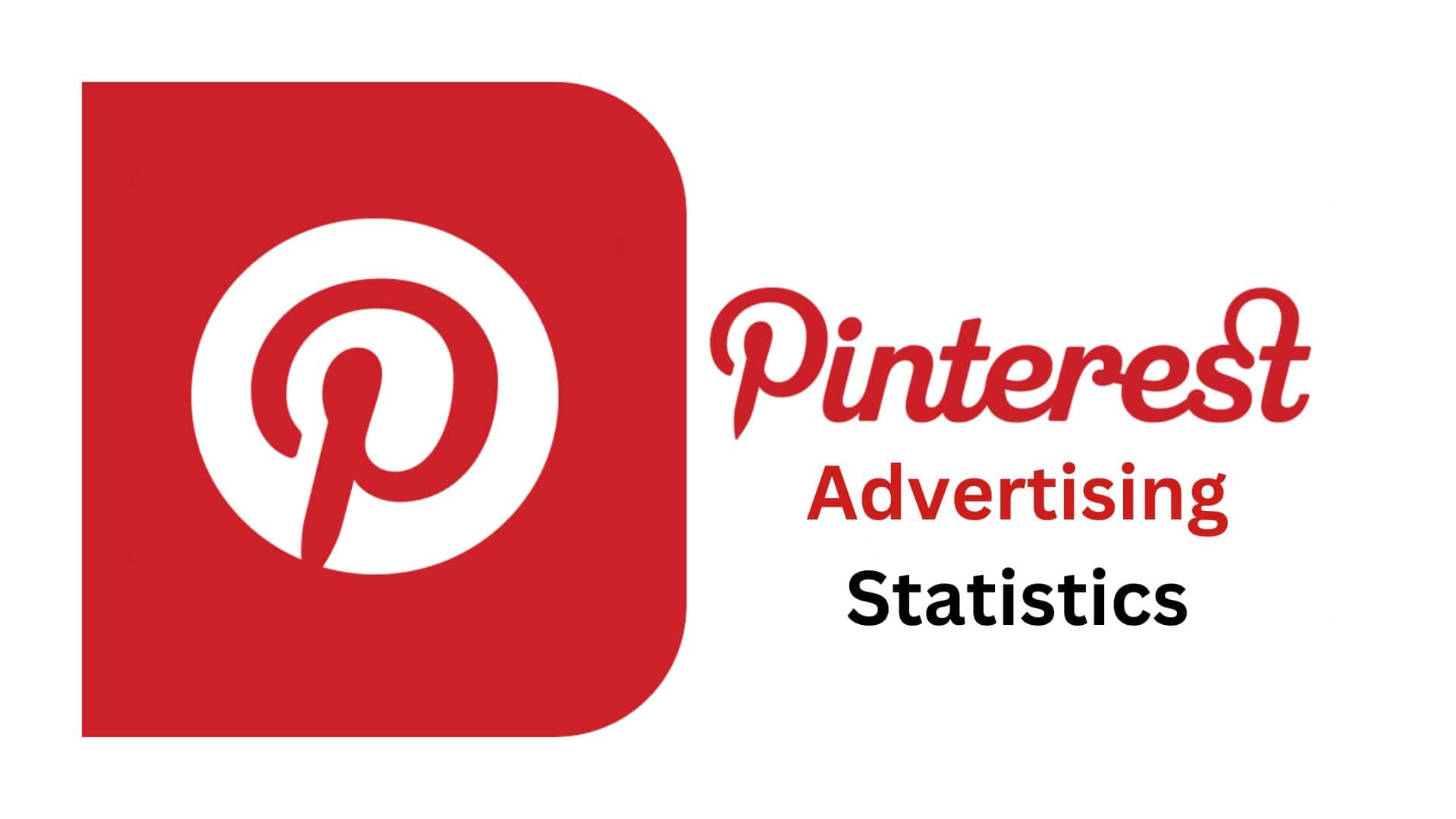Bing Statistics | By User, Country, Market Share And Facts (2025)
Updated · Aug 29, 2025
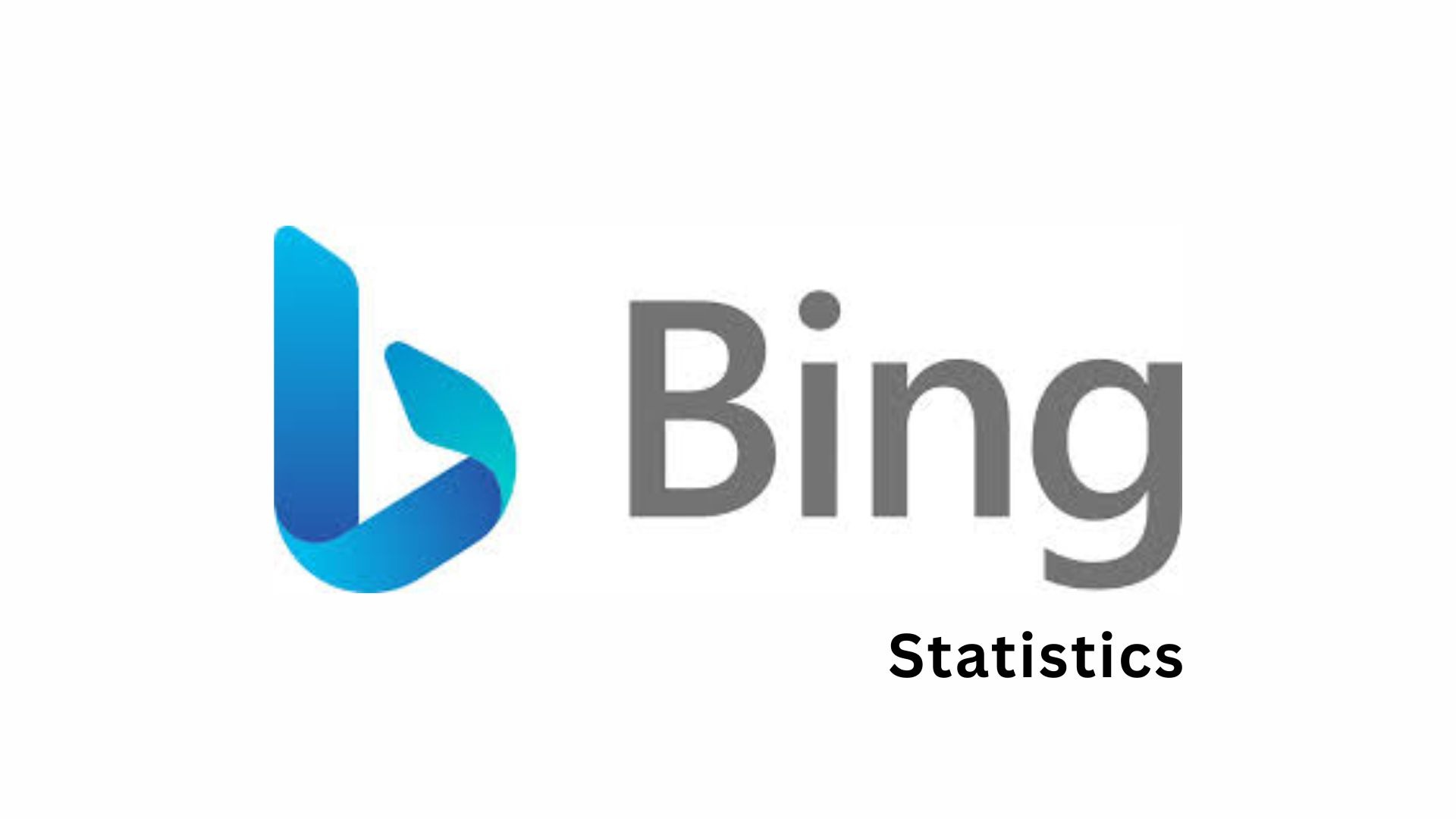
Table of Contents
- Introduction
- Editor’s Choice
- Bing Market Share
- Search Engine Market Share of Bing In the US
- Distribution of Bing.com Traffic 2025, By Country
- Total Global Visitor Traffic To Bing.com
- U.S. Customer Satisfaction With Internet Portals And Search Engines
- Bing Advertising Revenue
- Bing Valuation
- Global Bing User Base
- Web Traffic Refers To Bing.com 2024
- Bing Social Media Referrers
- Bing Users’ Spending Behaviour
- Conclusion
Introduction
Bing Statistics: Being Microsoft’s search engine, Bing has a path sewn into the global search market since its inception in June 2009. For a good number of years, it was long under the shadow of Google; the recent growth of Bing across devices, user counts, and revenues has been rather measured and steady. The year 2024 saw Bing fortify its position further, especially on the desktop side and more so with AI integration such as Copilot.
This article assumes a number-driven look at all Bing Statistics in 2025—market share, users, revenue, geographical reach, and technological advances, all explained in simple terms.
Editor’s Choice
- In 2025, Bing holds around 4.01% of the global search market, making it the second-largest search engine after Google.
- Granted, Bing performs better on desktop, with 12.21% of the global desktop market share.
- In the U.S., Bing ranked with a market share of 7.5%, measured across all devices as of April 2025.
- China contributes more than 25% of Bing’s traffic globally, while the U.S. stands at 22%.
- Bing.com was visited by 1.4 billion unique visitors worldwide in March 2024, a number that witnessed a rise from 1.3 billion just some months earlier.
- By May 2025, 27.12% of Bing.com traffic was coming from the U.S., followed by China, which contributed 14.16%.
- Bing continued to witness strong growth in ad revenues and earned an estimated US$12.58 billion in 2024.
- Bing’s estimated valuation has appreciated over the years, and the valuation method has estimated it to be around US$400 billion in 2023.
- About 1.1 billion users are estimated worldwide, with the U.S. contributing around 627.8 million users, India 250.7 million, and Brazil 185.4 million, and other countries making up the remainder.
- Almost all the Bing.com traffic comes from Microsoft-owned websites, with 42.43% of the referral traffic coming from ntp.msn.com and 25.41% of the referrals from msn.com.
- YouTube is the largest social referrer for Bing.com, accounting for nearly half of Bing’s social referral traffic, while Facebook is next with approximately 16%.
- Among Bing users, 54% are married, 59% have children living at home, and 34% have an associate degree.
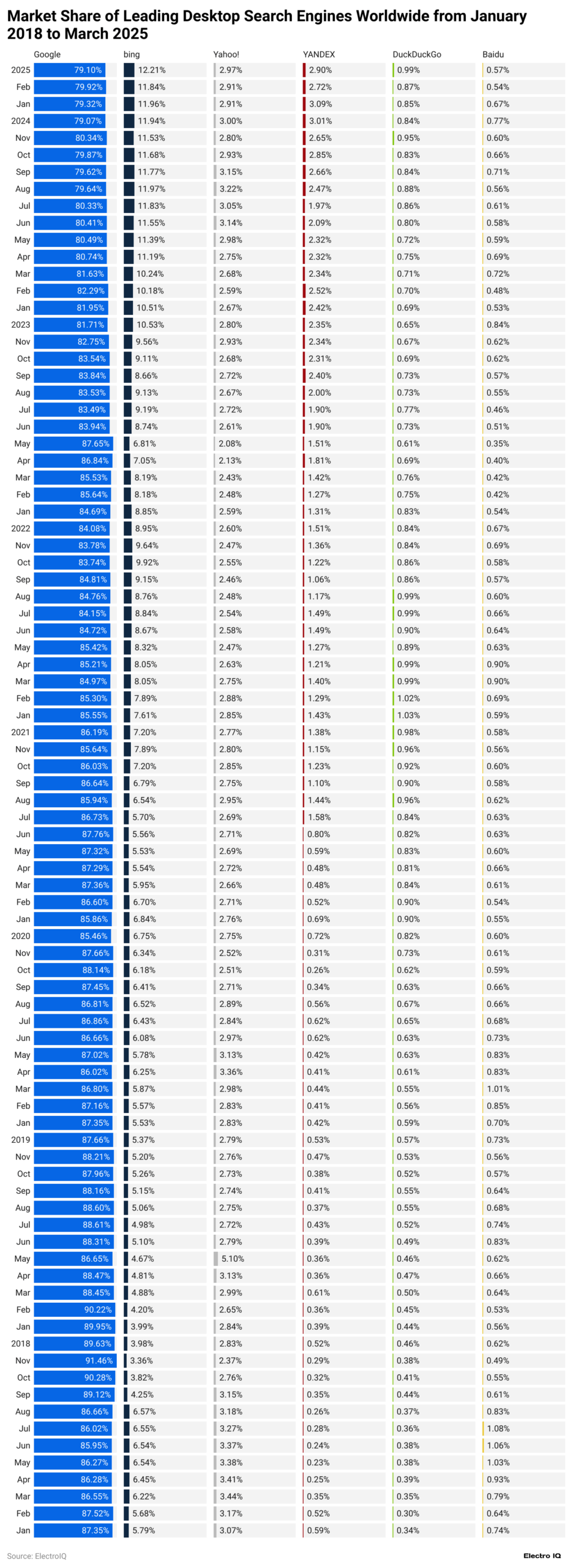
(Reference: statista.com)
- Bing continues to hold the second position in the search engine rankings worldwide, with a share of about 4.01%.
- Ranking third is the Russian search engine Yandex, with roughly 2.51%. Their strength varies based on the region and the device.
- For example, Bing is more present in desktop search, holding a share of 12.21% in the worldwide desktop search market.
- Local search engines perform best within their local regions, with over 63% of internet users in Russia resorting to Yandex and Baidu continuing to hold the largest share of the Chinese market.
- These splits suggest that local search engines can compete effectively with Google in their respective countries.
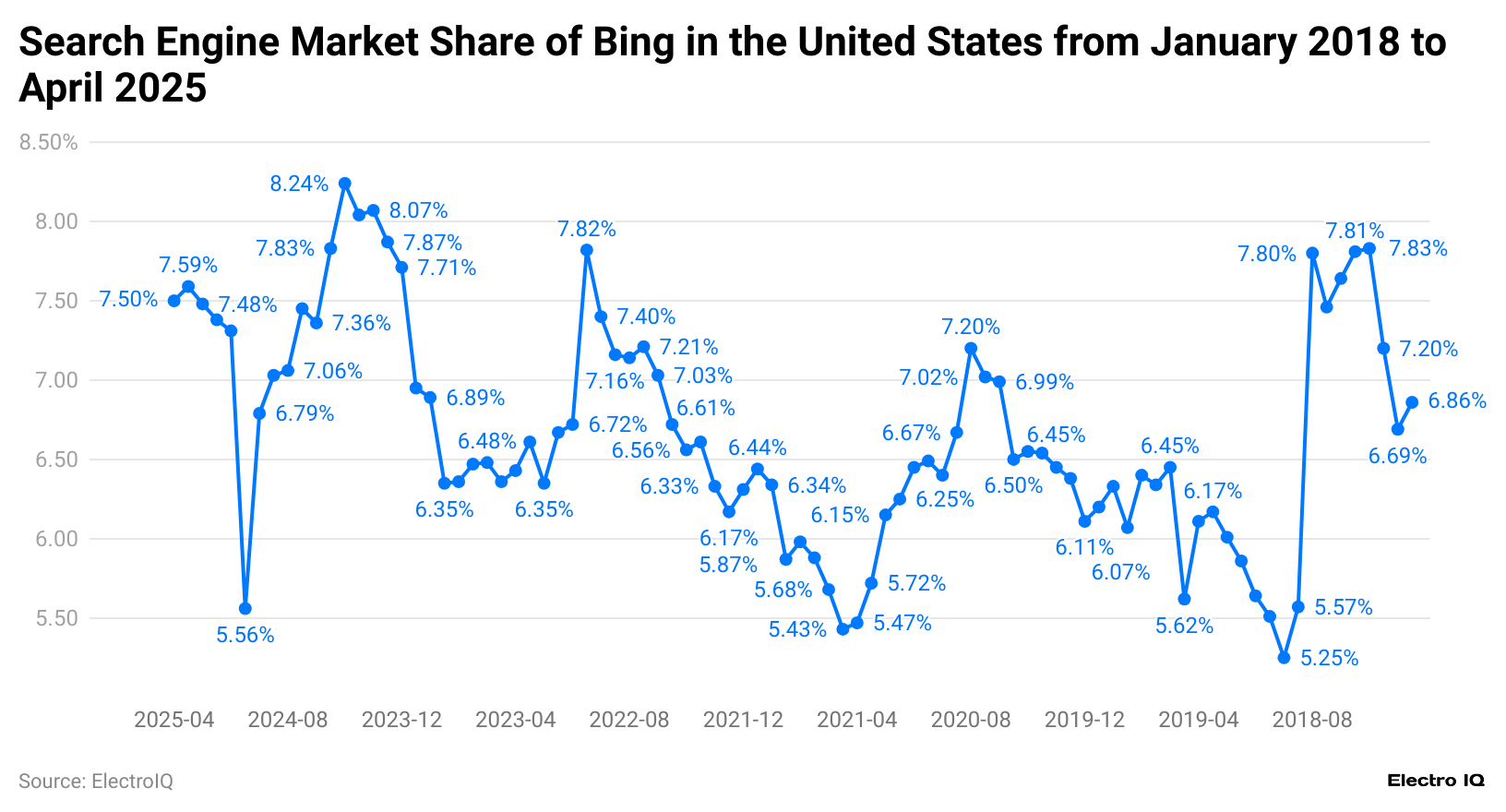
(Reference: statista.com)
- By April of 2025, Bing’s market share had grown to 7.5% across all-device searches in the United States, thereby entering one of the highest marks it has ever set in that country.
- In terms of search share, the United States, therefore, ranks among the top countries from Bing’s perspective.
- Although it is growing in the U.S., China continues to contribute more than 25% of Bing’s global the highest contributor to Bing’s worldwide traffic.
- The United States comes second, contributing nearly 22% to Bing traffic.
- This goes on to say that, although Bing is gaining ground in the U.S., a larger chunk of its users is still Chinese.
Distribution of Bing.com Traffic 2025, By Country
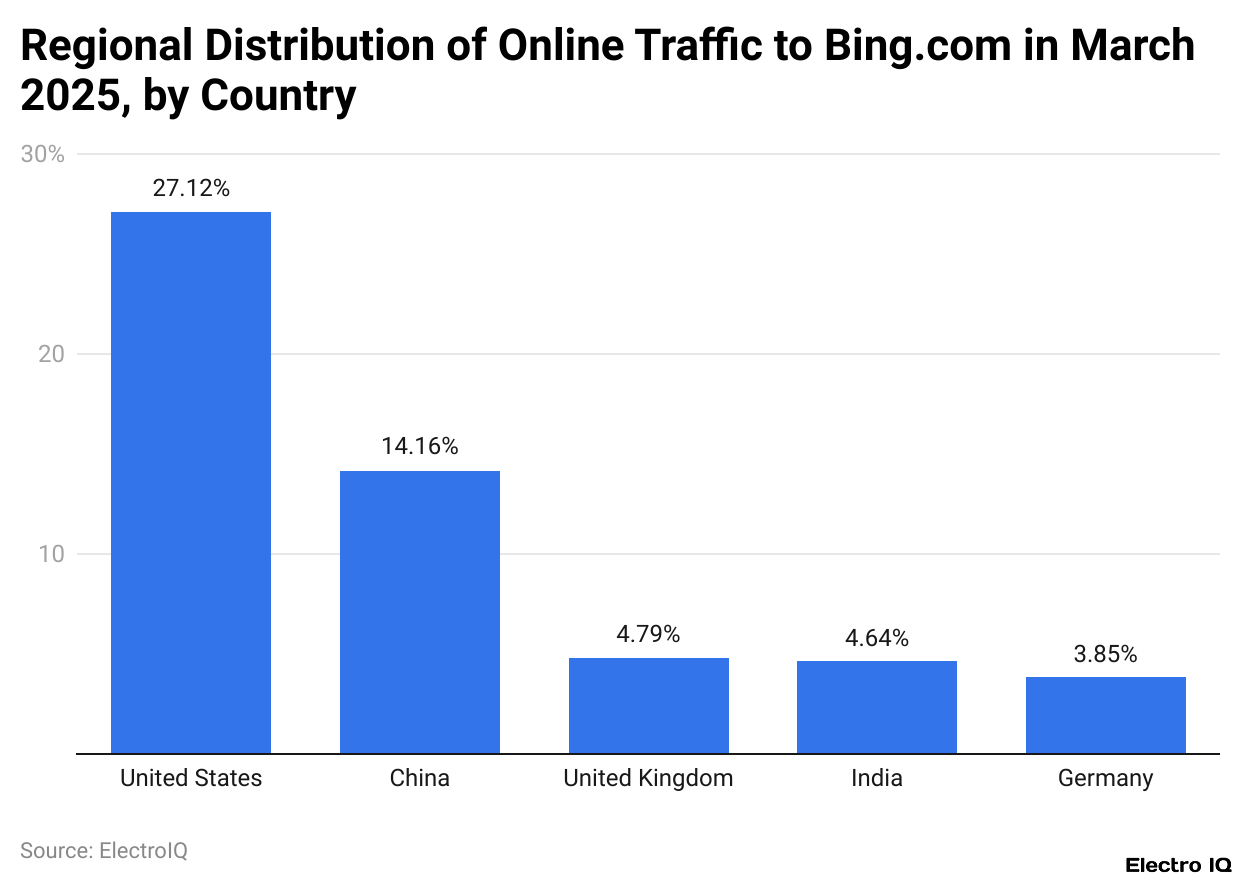
(Reference: statista.com)
- As per a Statista report, Bing Statistics show that with 27.12% of all visits in May 2025, the U.S. has over a quarter of traffic.
- In the same period, China accounted for the second largest number of visitors, contributing 14.16% of total traffic to Bing.
- Next in line was the United Kingdom, with India and Germany following close behind. Each of those countries, on the other hand, did not register beyond 5% of total web traffic to Bing.
- It follows that the U.S. and China act as major sources of visitors to Bing, and then countries such as the United Kingdom, India, and Germany are playing some small yet noticeable role in the platform’s global usage.
Total Global Visitor Traffic To Bing.com
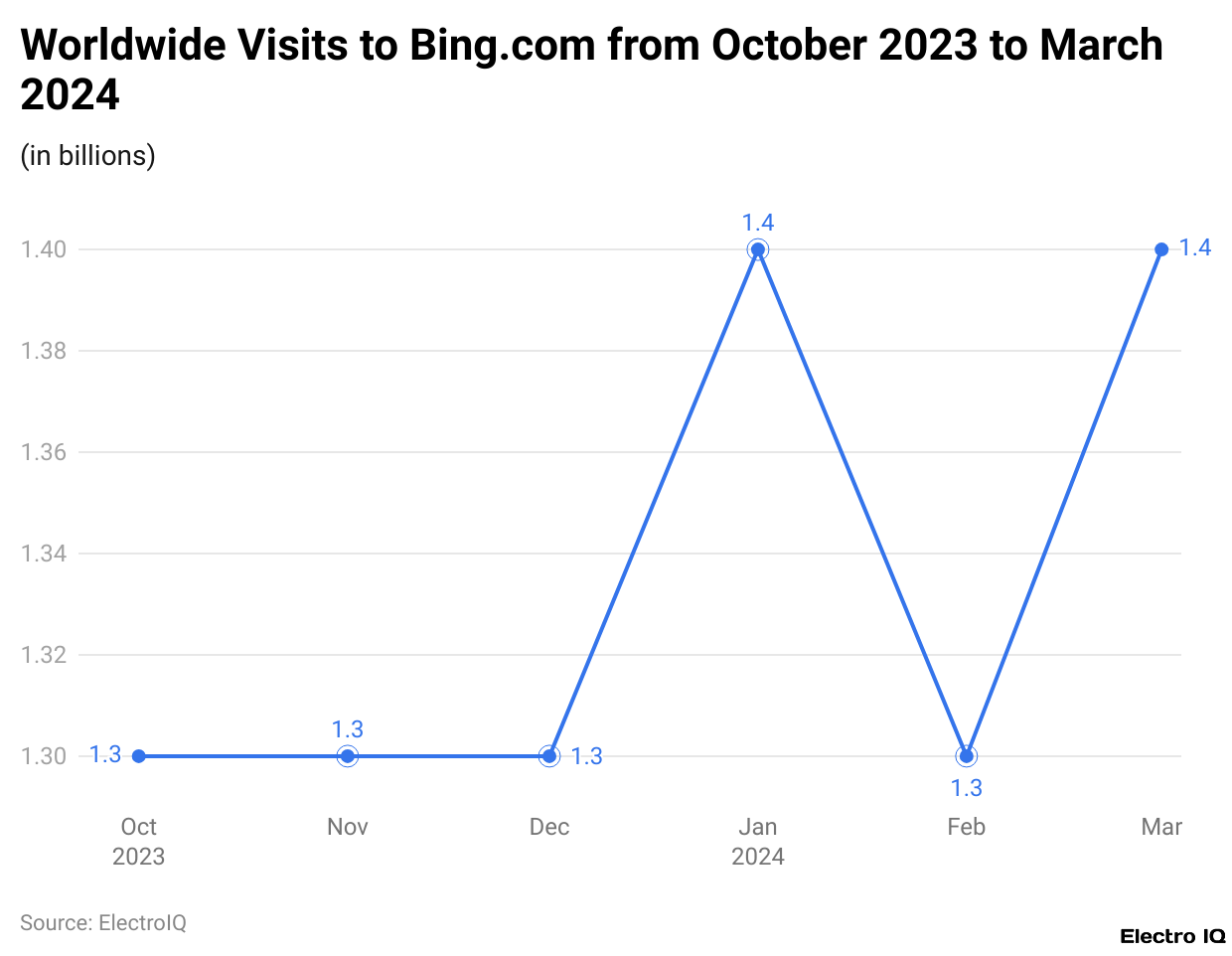
(Reference: statista.com)
- In March 2024, more than 1.4 billion distinct users were recorded worldwide for Bing.com. This showed an uptrend in user activity just a few months earlier, with 1.3 billion visitors.
- This speaks to the ever-increasing popularity Bing is achieving globally.
- The search engine owned and operated by Microsoft is experiencing a meteoric rise in popularity, with many uphill-downhill trying and adopting the platform.
U.S. Customer Satisfaction With Internet Portals And Search Engines
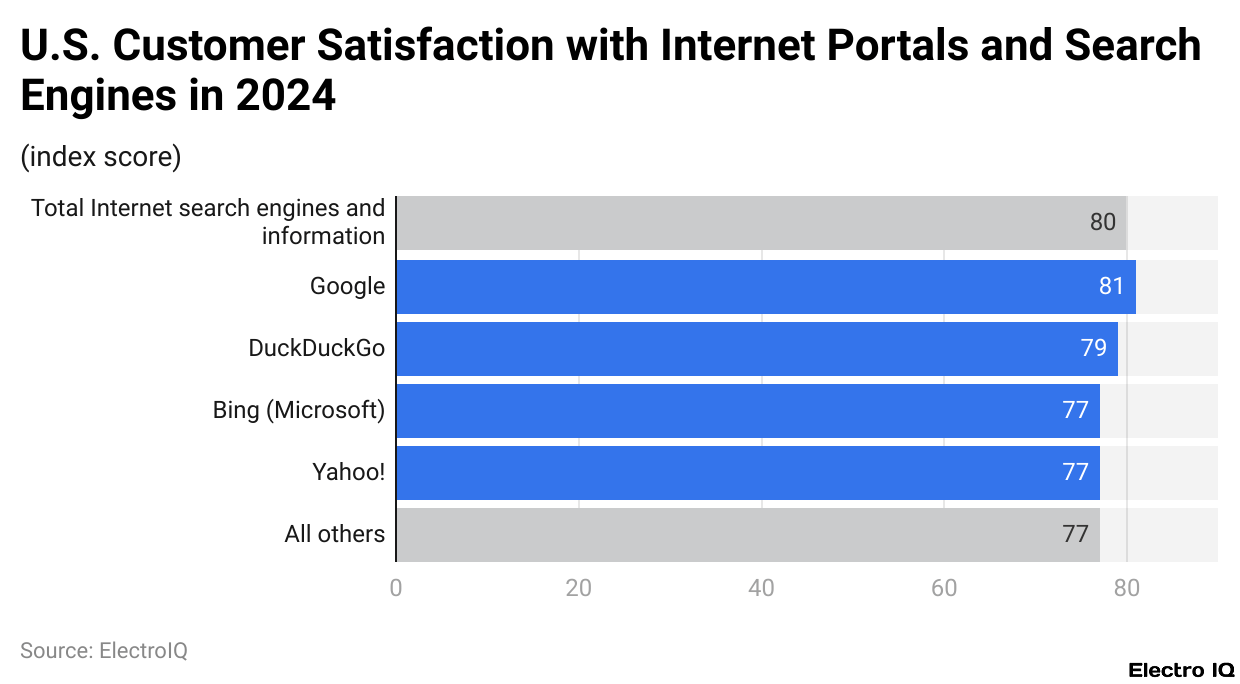
(Reference: statista.com)
- By June of 2024, internet search engine customer satisfaction stood at 80 on an index scale in the United States.
- Among individual search engines, Google ranked higher by four points at 81, so it enjoyed the highest customer satisfaction rate.
- DuckDuckGo, after it, got 79. Bing and Yahoo! attained nearly equal ratings of 77, which means there lay some slight disparities of satisfaction when compared to Google and DuckDuckGo.
- Other unnamed search engines are rated 77 and rank at the same level in terms of customer satisfaction as Bing and Yahoo!
Bing Advertising Revenue
| Financial Year |
Revenue (USD)
|
| 2024 |
$12.58 billion (projected)
|
| 2023 | $12.21 billion |
| 2022 | $11.59 billion |
| 2021 | $8.53 billion |
| 2020 | $7.74 billion |
| 2019 | $7.63 billion |
| 2018 | $7.01 billion |
| 2017 | $6.22 billion |
| 2016 | $5.43 billion |
(Source: meetanshi.com)
- As per Meetashi, Bing statistics reveal that search advertising is the main monetising option for Bing.
- In 2012, Bing commenced testing alternative ad headlines on its search result pages.
- This small change conversely improved users’ attitude toward ads and gave Bing a US$100 million revenue boost- that shows the potential power of small changes in design.
- Reflecting upon the Bing Ads revenue through the years, a picture emerges of strong growth.
- Bing’s advertising revenue for 2016 was US$5.43 billion.
- It then rose to US$6.22 billion in 2017, went further up to US$7.01 billion in 2018, and kept growing to US$7.63 billion in 2019.
- Revenue went as high as US$7.74 billion in 2020, and then that of 2021 saw a rapid acceleration to US$8.53 billion.
- In 2022, Bing earned US$11.59 billion in advertising.
- The very next year, in 2023, it became US$12.21 billion.
- For 2024, the ad revenue for Bing is expected to be around US$12.58 billion.
- It is that clear an upward trend that has seen Bug’s advertising business grow immensely over the years, and it is still a major source of profit for Microsoft.
Bing Valuation
| Year |
Estimated Valuation
|
| 2024 |
$12.21 billion (Revenue-based)
|
| 2023 | $400 billion |
| 2022 | $400 billion |
| 2021 | $395 billion |
| 2020 | $235 billion |
| 2019 | $214 billion |
(Source: meetanshi.com)
- According to SignHouse, Bing statistics state that Bing’s estimated valuation has been steadily rising with time.
- It was valued at around US$214 billion in 2019, which grew to about US$235 billion in 2020.
- In 2021, it was estimated at US$395 billion and steadied at around US$400 billion in both 2022 and 2023.
- Now for 2024, a revenue-based estimation places Bing’s valuation at US$12.21 billion, which looks to be a very tight revenue-based calculation, not full market value.
- All in all, while the reported numbers differ based on the method of valuation, the overall indication is that Bing’s worth is growing steadily each passing year.
Global Bing User Base
About 1.1 billion people around the globe use Bing. A large chunk of the user base is provided by some countries where Microsoft devices are more common, along with English-speaking users.
United States
- The United States has a large user population.
- The unique user accounts Sat at around 627.8 million, which means 29.61% of Bing’s monthly traffic is through the United States.
- One of the biggest reasons would be that Microsoft is an American company, and Bing is integrated with Windows operating systems that are commonly used in the United States.
- Therefore, it becomes a convenient and familiar thing for people.
India
- Google remains the dominant search engine in India; however, Bing is still popularly used by many people, especially younger users in cities who know English.
- India accounts for about 250.70 million Bing users, constituting around 11.82% of the total Bing traffic.
Brazil
- Brazil also has a sizeable number of Bing users, with around 185.40 million users constituting approximately 8.74% of total Bing traffic.
- Brazilians appear to like Bing for its search result possibilities; to be more precise, it gives localised search results that the searcher prefers.
Other Countries
- Countries that largely house Bing users are Germany, the United Kingdom, China, Japan, France, and Poland.
- Though comparatively less than in the top three, each of these countries contributes quite significantly.
Web Traffic Refers To Bing.com 2024
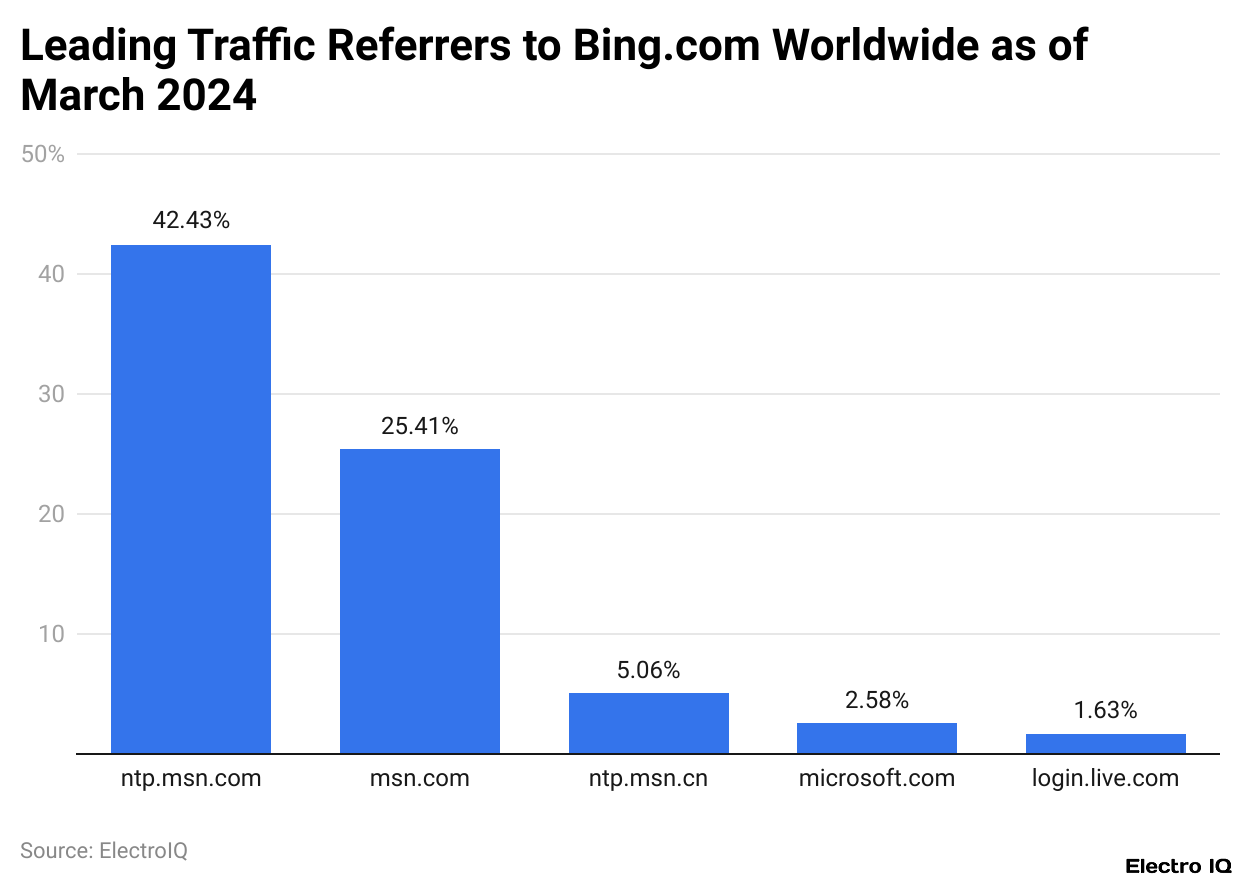
(Reference: statista.com)
- A nationwide user base of Bing was sourced from traffic coming from other Microsoft sites as of March 2024.
- More than 42.43% of all referral traffic to Bing.com came from the specific URL ntp.msn.com; therefore, nearly one-half of Bing’s visitor traffic is being directed from this source.
- The second largest referrer to Bing was msn.com, sending 25.41% of all referral traffic.
- This implies that more than two-thirds of Bing’s incoming traffic is generated from Microsoft’s own MSN pages and thereby acts as an essential highway for directing users toward the Bing search engine.
Bing Social Media Referrers
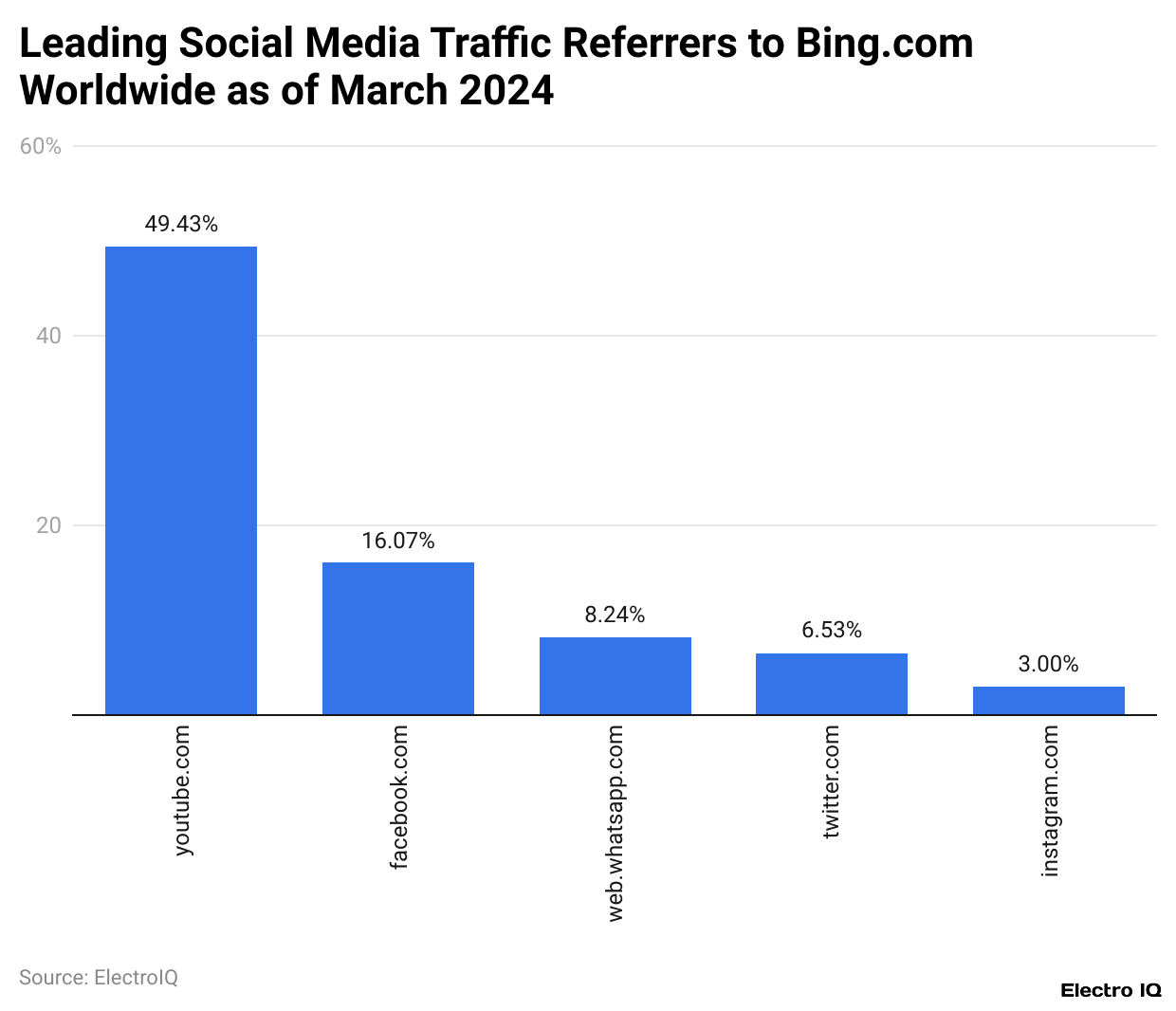
(Reference: statista.com)
- As of March 2024, YouTube.com stood supreme in delivering social media traffic to Bing.com, accounting for almost all social media referrals to the website.
- This shows that a large percentage of those who landed at Bing’s website had clicked links associated with YouTube.
- The second largest social media referrer for Bing was Facebook, which accounted for 16% of social referral traffic.
- While this figure indicates the dominance of YouTube, it shows that Facebook also still sends a lot of users to Bing from social platforms.
Bing Users’ Spending Behaviour
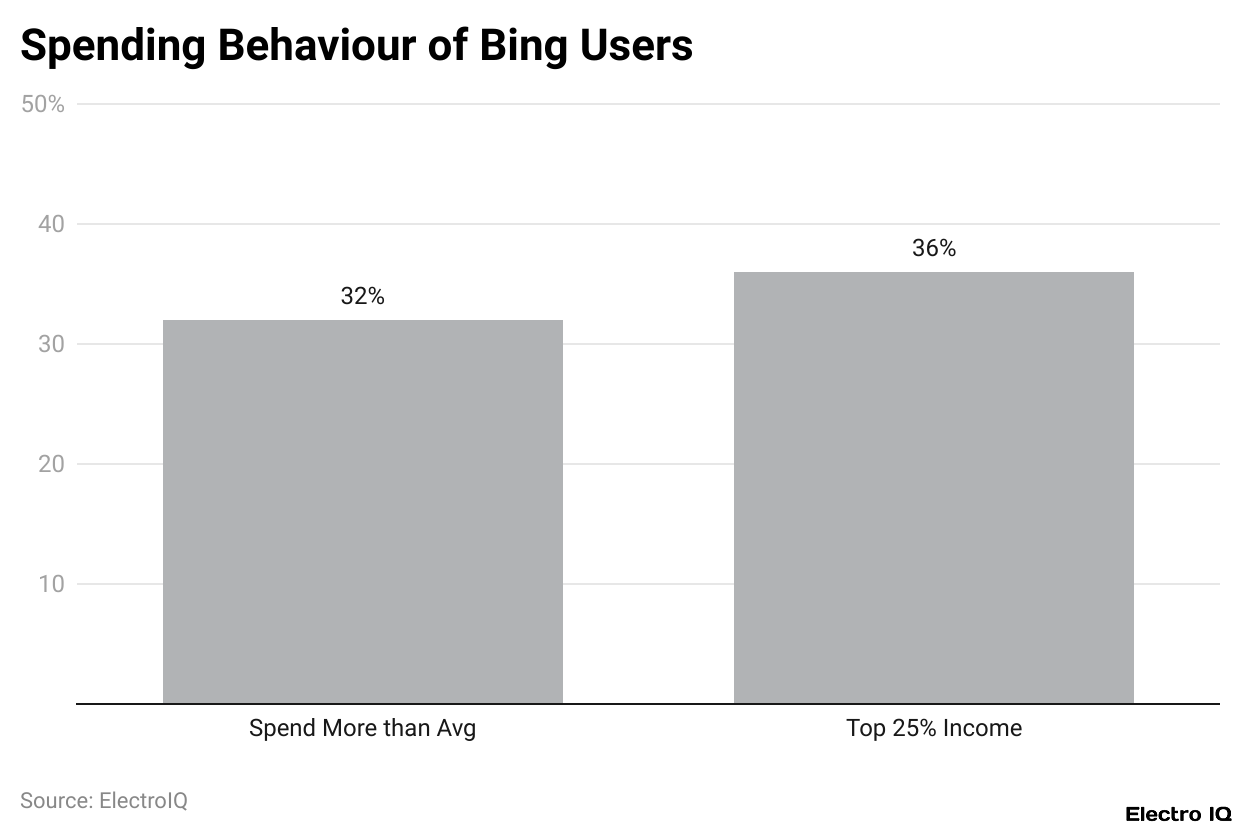
(Reference: nerdynav.com)
- According to Microsoft Advertising, Bing Statistics show that those who tend to use Bing are considered active shoppers or somewhat affluent when compared to the general internet user.
- The report says approximately 32% of Bing users spend more money online than the average web user, with 36% falling into the top 25% income bracket.
- Demographically, around 54% of Bing users are married, and 59% have children residing with them.
- Additionally, 34% of all Bing users possess a college degree, indicating that the audience is generally educated.
- Behaviorally, 54% of Bing’s users choose the search engine to conduct product research online, implying that a large part of the Bing audience essentially uses the search engine to shop and research products.
Conclusion
Bing Statistics: Bing has nowadays claimed and held that one-step position as the second-largest search engine across the globe, through consistent growth in desktop usage, ad revenue, and the user base internationally. Though still far behind its competitor, Microsoft’s integration and AI ducting to Bing have been responsible for the increased traffic and profits.
Over a billion users give it a steady momentum as it sees more adoption across the U.S. and China, with the user demographics and their spending patterns that also pave the way for advertisers to go forward.
FAQ.
Bing holds only a 4% share in the global search engine market, thus situating itself in second position after Google, as of early 2025. While Google still dominates with nearly 90%, Bing has experienced great growth in desktop searches, holding over 12% of the world’s desktop search share.
Bing is used the world over by about 1.1 billion people. The United States is the single largest contributor, with almost 30% of all users being in the United States; India and Brazil follow. China is also starkly important in Bing’s ranking in global traffic, in some metrics numbering more than 25% of visits worldwide.
Advertising continues to be Bing’s mainstay revenue, with the platform steadily growing over the years. Bing’s ad revenue subsequently topped an estimated US$12.58 billion in 2024, following growing revenues from US$11.59 billion in 2022 and US$12.21 billion in 2023.
Most of Bing.com’s web traffic is generated from other Microsoft sites. Nearly 43% of referrals in March 2024 arose from ntp.msn.com (the MSN browser homepage), with about 25% coming from MSN.com itself. Further, social media referrals are heavily influenced by YouTube, representing almost half of Bing’s social traffic, while Facebook comes second at about 16%.
Bing users tend to be fairly affluent and active online shoppers. Approximately 36% of users are in the top 25% income bracket, while 32% tend to spend more money online than the average internet user. Over 50% are married; 59% have kids at home; and 34% have college degrees.

I hold an MBA in Finance and Marketing, bringing a unique blend of business acumen and creative communication skills. With experience as a content in crafting statistical and research-backed content across multiple domains, including education, technology, product reviews, and company website analytics, I specialize in producing engaging, informative, and SEO-optimized content tailored to diverse audiences. My work bridges technical accuracy with compelling storytelling, helping brands educate, inform, and connect with their target markets.

